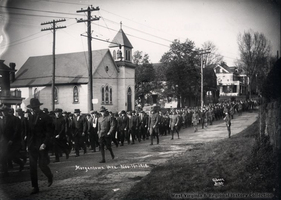
World War I had already embroiled the imperial powers of Europe in conflict for three devastating years before the United States declared war on Germany, April 6, 1917. The war ended less than a year and a half later with only a fraction of approximately 2,150,000 American draftees and 200,000 volunteers seeing combat. Thousands of Americans arrived in France, but never saw action, and many thousands more never departed bases in the United States. Nonetheless, more than 116,000 Americans died, many of them victims of the great influenza epidemic of 1918. Hostilities ended with an armistice on November 11, 1918.
West Virginia mustered 58,000 soldiers for World War I, suffering about 5,000 casualties including dead and wounded. The state’s two National Guard regiments had previously been mobilized for the 1916 Punitive Expedition in Mexico. They were reorganized as the 150th and 201st Infantry Regiments, under regular army command in the 38th Division. About 27,000 West Virginians who reached the war zone were deployed across the Western Front, but others participated in the 1918 Italian Campaign and the ill-fated Russian Expedition of 1919. Between May 1917 and September 1918, three drafts were held in West Virginia.
West Virginia’s casualties included 1,120 killed in action, 691 killed in training, and many wounded. Many others died of influenza and other diseases, often in camps on American soil. Among the dead, notables included aviator Louis Bennett Jr., who served with distinction with Britain’s Royal Air Force, and Capt. Timothy Barber of Charleston, who organized a volunteer ambulance unit prior to gallant service as an army surgeon. Although no Medals of Honor were awarded to West Virginians during World War I, many received decorations from European allies. Sgt. Felix Hill and Marine Pvt. Raymond White, both from Moundsville, received the French Croix de Guerre. Many West Virginia soldiers lie buried in U.S. military cemeteries in France. World War I memorials may be seen at Welch, Logan, Martinsburg, Huntington, and at the West Virginia Veterans Memorial in Charleston. The War Memorial in Kimball was the first building in the country erected to honor African-Americans who fought in World War I.
On the home front, World War I mobilized citizens and industry at unforeseen levels. Prior to U.S. involvement, many Americans questioned the Wilson administration’s move toward war. Some newspaper editors voiced pro-German sympathy, while opposing the British naval blockade of neutral shipping to Germany and its allies. After the May 1915 sinking by the Germans of the Lusitania, an unarmed English passenger liner with many Americans aboard, West Virginians and other Americans turned against Germany. State colleges discontinued German language courses during the war, while several counties held ‘‘loyalty meetings.’’ Statewide food and coal rationing went into effect during the war. Men and women volunteered as Red Cross personnel, while ‘‘Four-Minute Men’’ raised millions in Liberty Bonds sales across the state. Both the Charleston Ordnance Center and the Nitro gunpowder plant were built as part of the war effort, though neither saw production before the end of the war. Nitro, a Kanawha Valley community created by the war, experienced a fleeting wartime population boom of 25,000 and remains a major industrial center today.
The last living American veteran of the war was Frank Buckles, a Charles Town resident. Buckles, who enlisted at 16 and served as an ambulance driver in France, died on February 27, 2011. He was buried in Arlington National Cemetery with full military honors.
This Article was written by Jeffrey M. Leatherwood
Last Revised on November 28, 2018
Sources
Schaefer, Christina K. The Great War: A Guide to the Service Records of all the World's Fighting Men and Volunteers. Baltimore: Genealogical Pub. Co., 1998.
War Work of Marshall County, WV: The Fighting Forces and the Inner Lines. Marshall County: War Activity Committee, Nov. 1919.
Sprague, D. D. Charleston's Roll of Honor. Charleston: Charleston Printing Co., 1919.
Harper, R. Eugene. Wilson Progressives vs. DuPont: Controversy in Building the Nitro Plant. West Virginia History, (1989).
Saunders, Eugene F. "West Virginia Editorial Opinion on U.S. Entry into World War I." M.A. thesis, West Virginia University, 1950.
Monongalia Post of the American Legion. Souvenir program. West Virginia & Regional History Collection, West Virginia University Libraries, July 4, 1919.
U.S. War Department to West Virginia Adjutant General. Revised List of Deceased Soldiers [of the] World War. Charleston Department of Veterans Affairs, 1922, Reprint, 1961.
Cite This Article
Leatherwood, Jeffrey M. "World War I." e-WV: The West Virginia Encyclopedia. 28 November 2018. Web. 26 July 2024.



Comments?
There aren't any comments for this article yet.
Click here to read and contribute to the discussion →